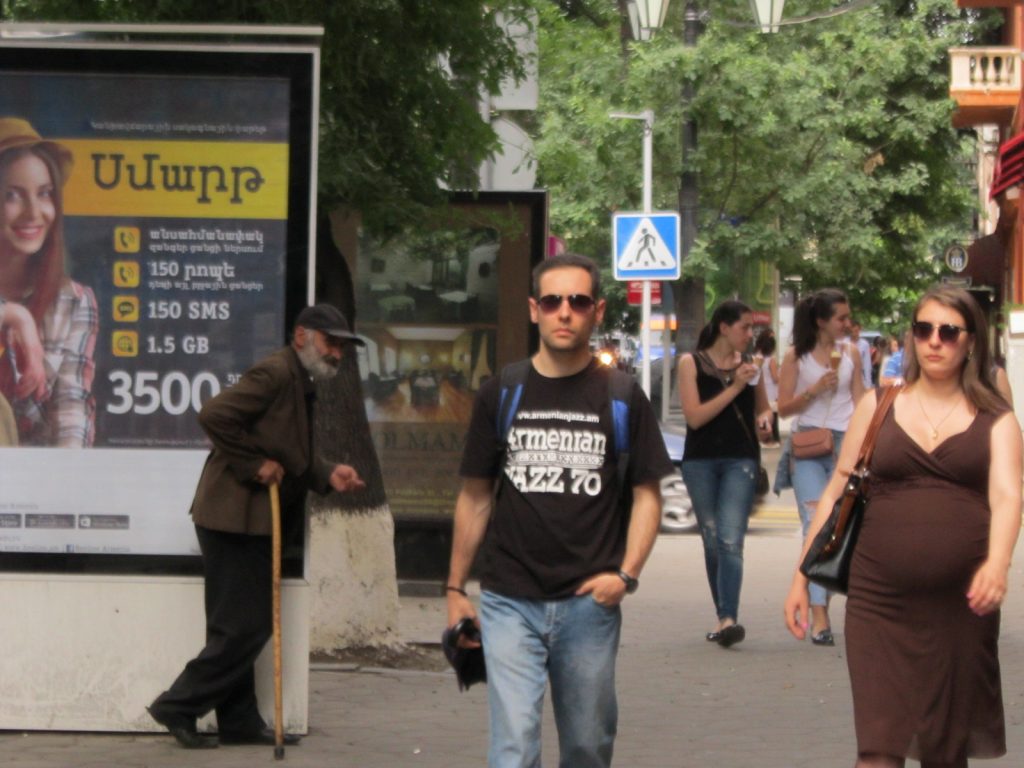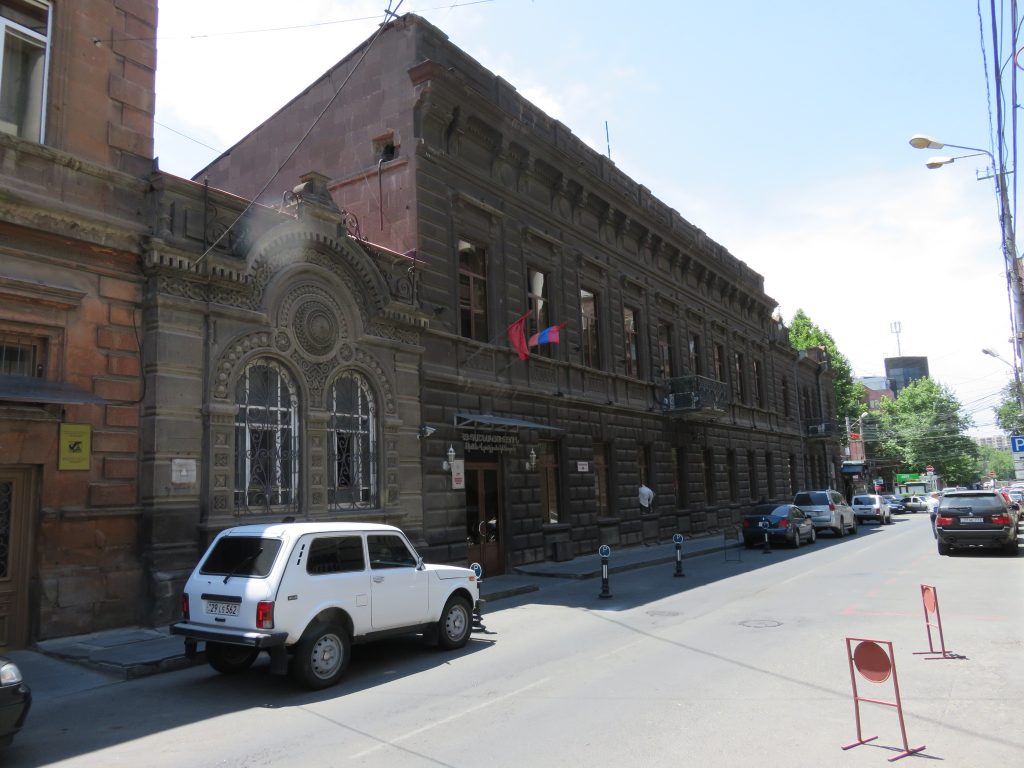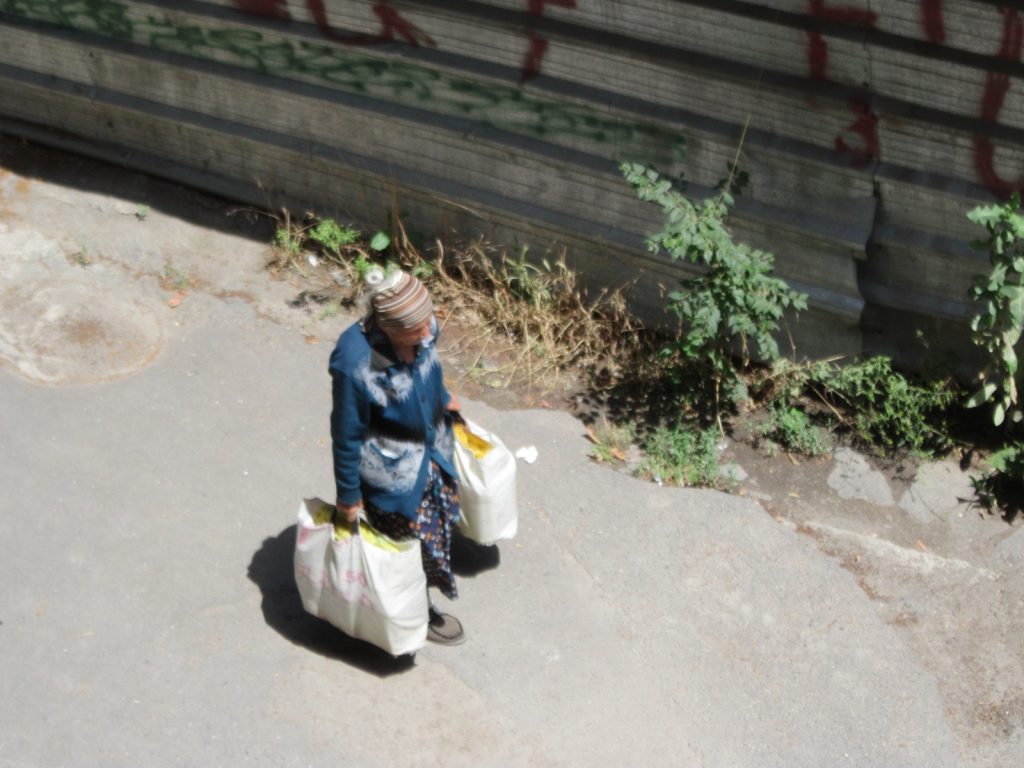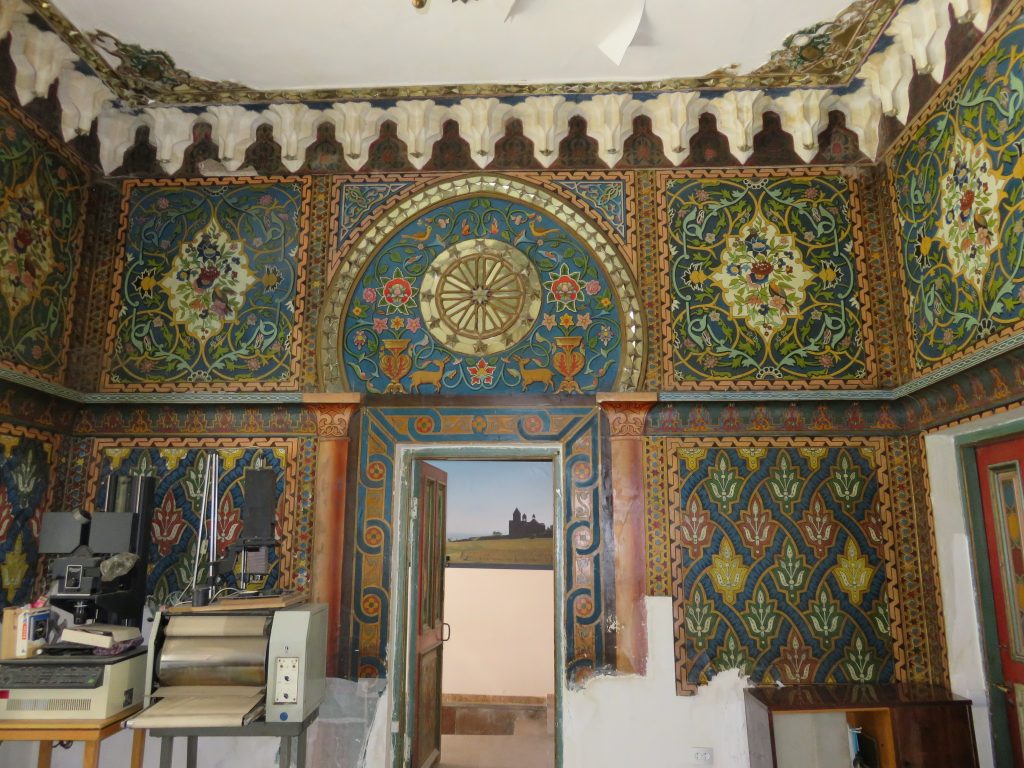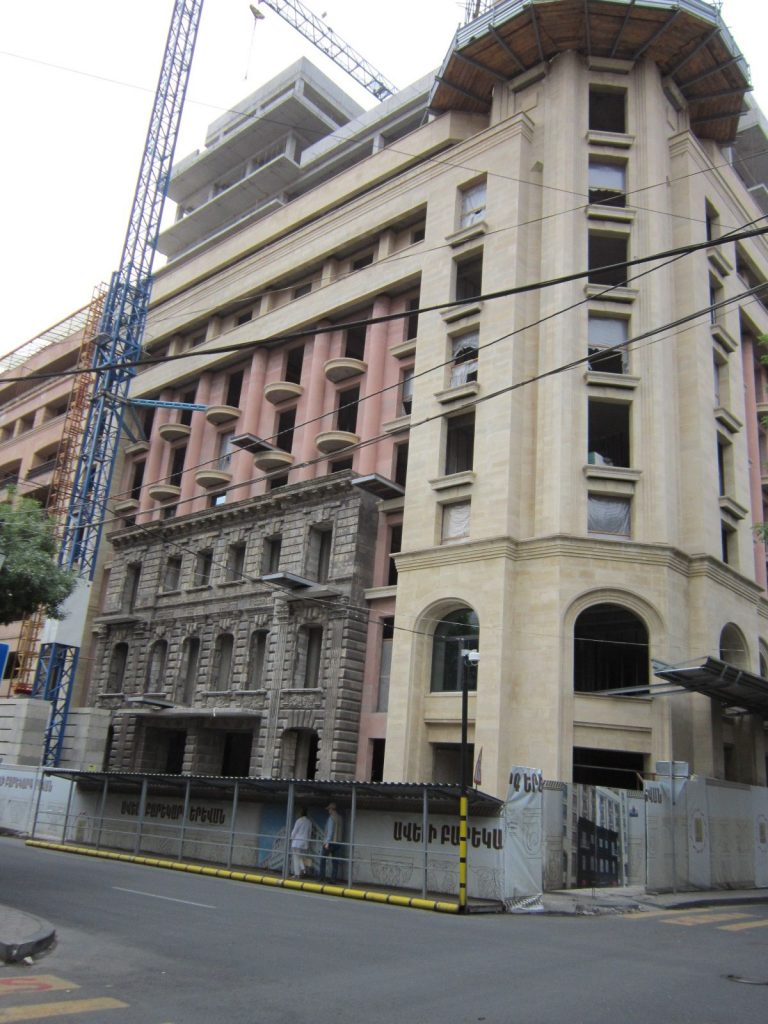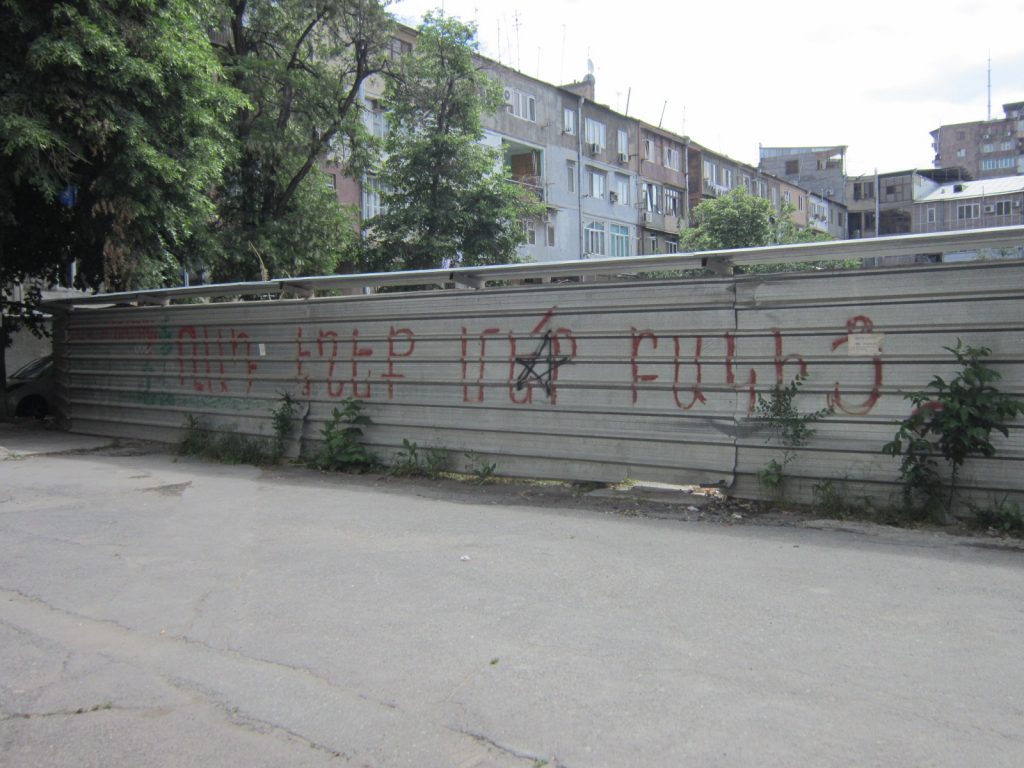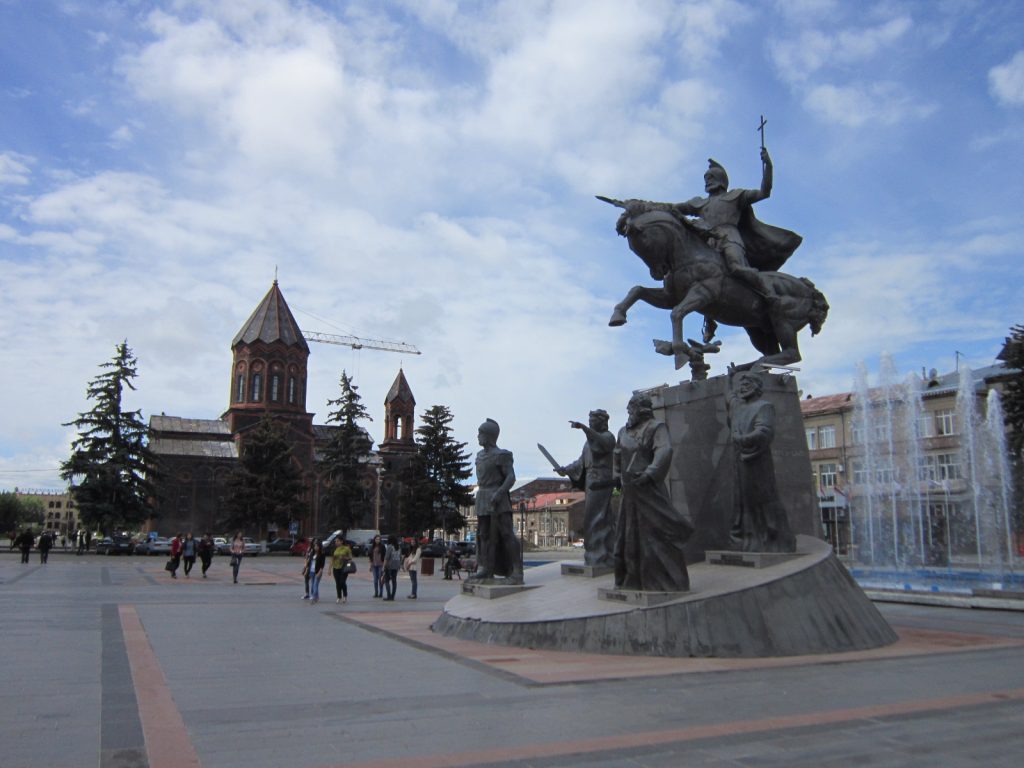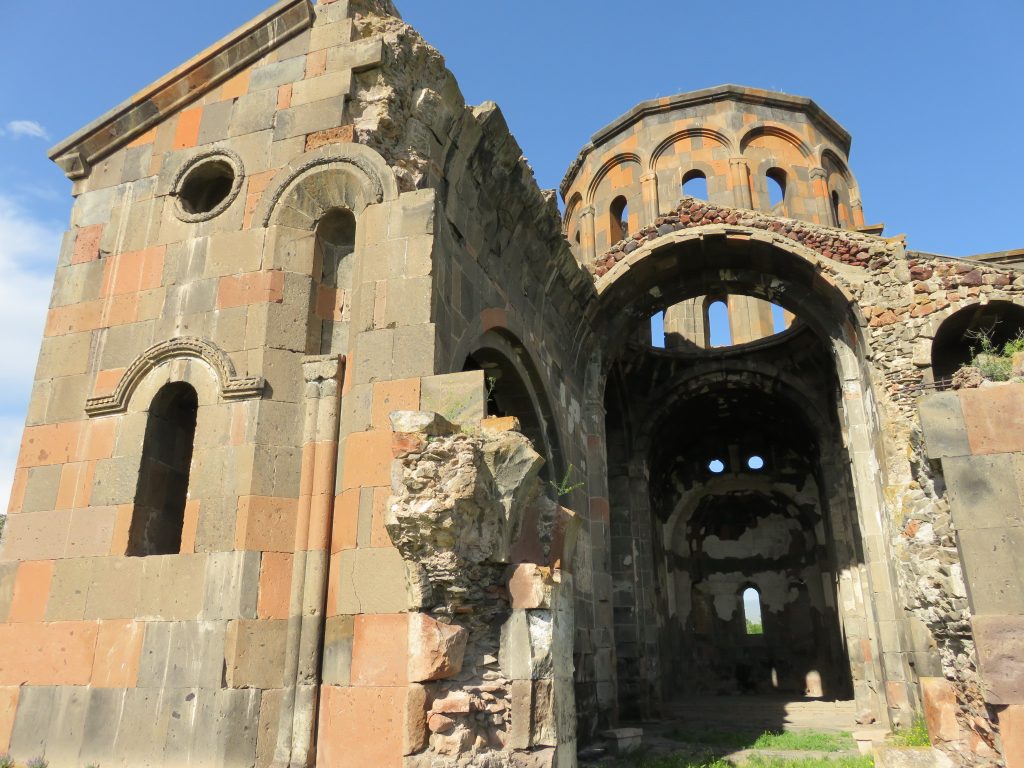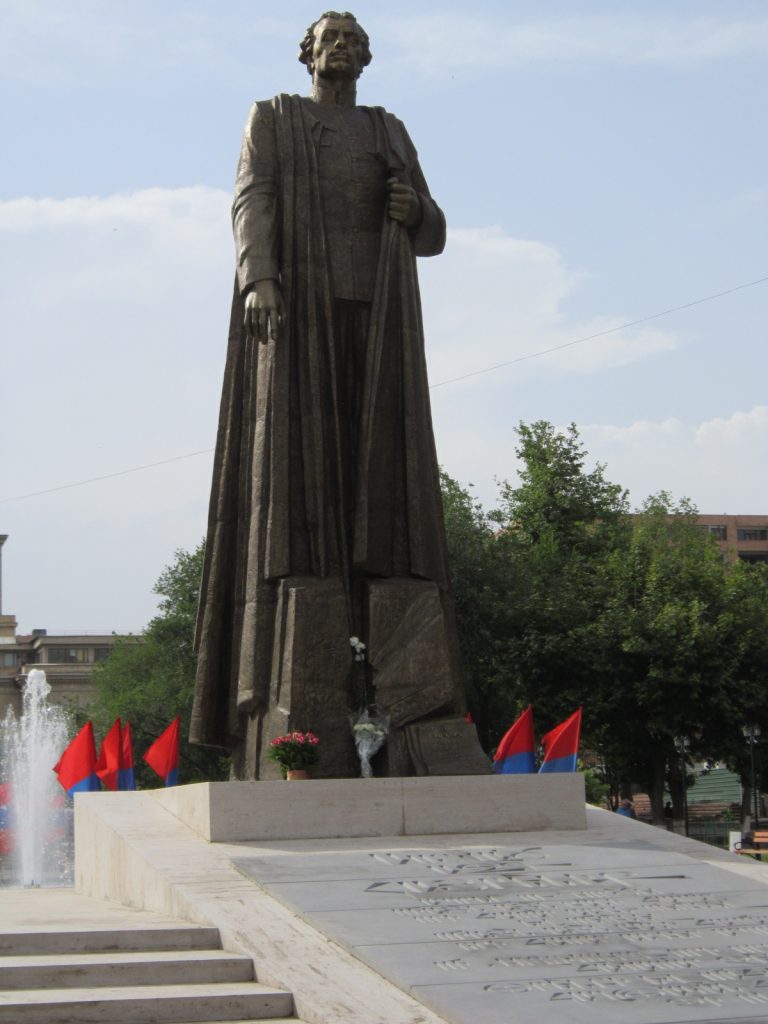Meneshian: Armenia Today
September 27, 2016Text and Photos By Knarik O. Meneshian
Two things should fill a person’s soul with wonder and reverence—a starry sky above and morality in one’s heart.
—Karekin Nejdeh*
August 2016
After 13 years, my husband and I finally returned to Armenia at the end of April 2016 for a two-month visit – this time not as volunteer teachers, but as tourists.
Our first impression of the capital was that of amazement and delight. Zvartnots Airport was modern and efficient and the uniformed staff was professional and welcoming. Yerevan appeared new, fresh, and vibrant. New buildings stood tall and gleaming; flowers adorned select areas of the city, where before there were none.
There was an array of new hotels, restaurants, cafes, eateries, stores, and other businesses, all with neatly groomed and uniformed staff. There were new traffic lights, and both pedestrians and motorists alike obeyed them – a remarkable and much welcomed change from years past.
There were more public restrooms, even in the outlying regions. A standard fee of 100 drams or 21 cents was charged, which helped pay the women who collected the fees and maintained the restrooms–again, a remarkable and much welcomed change from years past.
There were many tourists from places such as China, France, Germany, Iran, Italy, Japan, the Philippines, Poland, Russia, Scandinavia, and the United States. In front of the Alexander Spendiaryan Opera House, named after the renowned composer and conductor, teenagers rode rented bikes around its perimeter and children played or rode rented tricycles or battery-operated cars while parents or grandparents sat on nearby park benches and kept a watchful eye on their young charges. Behind them, cafes were full and music floated amidst the flowers that adorned walkways. People were walking up and down the walks, chatting on cell phones or licking ice cream cones.
People of all ages were better dressed. Young girls and women in high-heeled shoes wore trendy jeans and tops, while others wore slacks, skirts, or dresses. Their haircuts were stylish and attractive, as were their handbags. As we passed people on the streets, I remembered the days of extreme difficulty in Armenia, especially during the 1990s, and even then, people took pride in their appearance and dressed neatly when in public.
Walking about the city, we noticed that there were more young families with several children and more expectant mothers and fathers pushing baby buggies. People appeared to be better off and friendlier than in years past. What was striking for us was the change in their manner; they were more helpful and polite. Store clerks, restaurant workers, office workers, medical staff, cab drivers, people in general, sometimes smiled when we talked to them, especially when, after a brief chat or a greeting, we would say, “Dzez baree or (Have a nice day)!” They in turn would first respond with a look of surprise upon hearing the warm and friendly words and then reply, in a thankful tone, “I wish you the same.” Dressed in neatly pressed uniforms, police officers, both male and female, made their rounds, and young soldiers on furlough, both male and female, dressed also in neatly pressed uniforms, leisurely strolled the streets.
Northern Avenue, with its new apartment buildings–many not yet occupied–and wide walkway dotted with benches and plants, was often crowded with people strolling about during the daytime and evening. Republic Square, with its dancing, musical fountains, was lively in the evenings with locals and tourists of all ages enjoying the sights and sounds of this place that holds so much history. The nearby restaurants, cafes, and eateries were busy.
And in the daytime, the State History Museum of Armenia and its art museum were frequented by tourist groups and local schoolchildren accompanied by their teachers. The well-behaved and neatly dressed children, walking two by two, listened attentively to what their teachers, also neatly dressed, were explaining. The history museum was a place where one traveled through the halls of time of the once vast territory known as Historic Armenia: “cradle of ancient eastern civilization” and “one of the oldest centers of agriculture (wheat culture) and metal-working (copper, lead, iron)… remains the bearer of over five millennia of ethno-cultural heritage.”
The art museum was not only a place of discovery and reflection but also of wonder and awe at what the artists through the years, had created, expressed, and captured on canvas and other forms of art. Some pieces conveyed ancient, religious themes, and many others, secular. Unfortunately, the galleries that displayed the works of art had no proper climate control system. Windows, with rotting wood and flaking paint were open for airflow and the sun was shining on some of the paintings.
We noticed not only an increase in cars but also more expensive ones. Since our last visit to Armenia, motorcycles were something new; so too were the ear-piercing and annoying sounds of revving cars and motorcycles speeding up and down the streets, especially late at night. There were fewer marshutkas (mini-buses), a greater number of cabs, which were very affordable, and new buses. The buses were a bright and cheerful light-plum color. The subway, as in years past, was still a comfortable, quick, and affordable form of travel. Rarely did we see stray dogs as we did in previous years. The number of dog owners, however, had increased.
People of all ages, especially parents with their young children, were attending cultural events from musical festivals held on the streets of the city to operas, plays, and poetry readings. At the Arabkir Children’s Hospital in Yerevan, the miracle of birth had taken place in early June. The birth was truly a miracle and a first for Armenia because the young mother – a kidney transplant patient on anti-rejection drugs (with a kidney donated by her mother), who had suffered three miscarriages as a result of her medications–finally delivered a healthy boy.
The more my husband and I strolled the streets of Yerevan, observing and talking to people of all ages, the more we began to take a closer look at the conditions that at first escaped us. People in a variety of professions, including menial job workers, the indigent, and the elderly, helped form a picture that did not correspond with the dazzle that had captivated us at first. Whether staff at business establishments, churches, museums and parks, or street merchants, cab drivers, laborers, medical and office workers, the elderly, and the indigent, their sentiments were the same: disillusionment, frustration, and hopelessness.
Definitely, Yerevan–and the entire country–had come a long way from the dark, cold, hungry, and extremely difficult days after the 1988 earthquake and liberation of Artsakh, and the uncertainty that followed Armenia’s independence in 1991. Indeed, the fledgling independent country had made great progress since those days and its first presidential election.
I was in Armenia as a volunteer teacher in the village of Jrashen, next to Spitak when that momentous election took place. The village officials gave me special permission to vote because my father had been from Armenia. During the voting process, I, like all the villagers, was “assisted” as to whose name to write on my ballot. If one was unable to write, one was shown where to make the appropriate X mark. Indeed, those were exciting days, and people were filled with the greatest of hopes and dreams for a better life – finally – despite the insurmountable hardships that had befallen them. Their hopes and dreams lived on for a long time, even with the adversity they and their children patiently endured during those early days of nationhood: days replete with what was considered by many to be “growing pains.”
Over the years, beginning in the Soviet days, I kept in touch with family and friends by letters and occasional phone calls; with the advent of the internet I began communicating by email. From time to time, I had the privilege of visiting my family and friends in Armenia. Because of the correspondences and visits, I was not only able to read their first-hand accounts but also to see the changes in them and their lives, whether in the city or village, and in the country. To say that their and their children’s lives–and, now, their grandchildren–have improved would not be totally accurate.
Superficially, life may appear better to the casual visitor, similar to someone looking at a scar with makeup. Indeed, there are now greater varieties and an abundance of mostly important consumer goods such as food, clothes, shoes, household goods, furniture, electronics, cell phones, and vehicles. There are even nice-looking, modern pharmacies offering a variety of medicine and health and personal care products, walk-in clinics, many beauty salons, and high-end boutiques and shops. But, according to a distraught and lamenting mother of a young man, there are no alcohol and substance abuse rehabilitation centers.
Modern malls have replaced the sprawling, Soviet era, GUM indoor markets. It appears that people are buying more. But one wonders, how? How do people afford these things when there is so much unemployment, low-wage employment, and temporary employment? An answer: Some who can afford it temporarily leave the country to work and then return, and then leave again to work. Some never return to the homeland. Many rely on financial aid from family and friends abroad. During the country’s extremely harsh and uncertain early years, people would excitedly speak with wide-eyed anticipation of their hopes and dreams for a better life coming to fruition one day in Armenia. “It will happen! It will happen!” they would say with confidence.
Amidst the variety and abundances of goods, something else appears throughout the city and environs, and they are not few. They are the “Vajarvoom Eh (For Sale)” signs. These big and small signs are on large and small buildings – some new, some unfinished, some old – and on storefronts, apartment building windows, and even sheds. Some establishments have signs stating, “For Rent or Sale.” On the road to Sardarabad, for example, amidst the “Vajarvoom Eh” signs, there were areas that looked like ghost towns with dilapidated and abandoned homes, stores, factories, and other businesses. Along the roadsides, there were rusted remains of cars and buses partially hidden by weeds.
The Sardarabad Museum showcases and traces Armenia’s ancient to modern people; tools and other items used in daily life throughout the ages; clothing, carpets, foods, and jewelry; modes of transportation, and accounts of the Genocide. On the grounds, close to the museum, stands the enormous Battle of Sardarabad Monument and Bell Tower surrounded by flower gardens. Years before, when we had visited the grounds and the toilet facilities outside the museum, both were in better condition. The nearby, large Soviet era restaurant, which once served many, was shut down. Now, across from it was a smaller restaurant, with charming Armenian décor and a tonir (oven) where lavash (flatbread) was baked. When I asked the young restaurant worker if people often frequented the restaurant, she replied, “Sometimes a few tourists or schoolchildren with their teachers stop at the restaurant for a meal after visiting the museum, the monument, and the grounds, but then there are days when no one comes.”
As she handed us menus, I thought, “What a shame to miss such a view from this restaurant’s porch of birds and flowers, fields, villages, and mountains!” Here, just as in the magnificent Zangezur region, the air is cleaner, the sun is brighter, and the sky is bluer.
Among the places infrequently visited or overlooked is the 7th century Talin Cathedral in the town of Talin. In the 1840 earthquake, the dome and other parts of the structure were destroyed. Though reconstruction work began in 1947, it was never completed. The dome and other parts of the church remain open to the sky. According to a weathered plaque outside the church, there are now only “traces of the portraits of the Six Apostles” and it is “the only surviving Armenian example of a wall painting showing Christ in a medallion with busts of the apostles.” Birds, insects, snakes, weeds, and the elements are now the cathedral’s worshipers. Behind the crumbling structure is a cemetery overrun by weeds. As I watched the weeds bend in the breeze and the birds fly over the graves, I wondered, “Who are the ones who have been here all these centuries?”
The Erebuni Historical and Archaeological Museum is a fascinating place, but its neglected grounds, excavation areas, and rebuilt segments of Erebuni’s ancient fortified city, founded in 782 B.C., are reasons for dismay and concern. Walls of the fortress were defaced with deep scratches and graffiti, used toilet paper was left in the weeds, and remnants of a khorovats (barbecue) were strewn in one of the rooms of the fortress.
The small Shengavit Museum and its ancient archeological site – dating back to the 4th millennium B.C. (initially excavated in 1936), and situated behind a hospital in the Shengavit section of Yerevan–is yet another place rarely visited. These fascinating and historically significant places, including the Zangezur region of Armenia, reveal captivating accounts of Armenia’s rich history and culture. It is in Zangezur where one can see and walk about Tatev Monastery, built up high in the mountains in 1295; pass by the caves where the world’s oldest shoe was discovered and is now on display at the State History Museum of Armenia; and see, touch, and walk about the Early Bronze Age Karahunj, an ancient observatory.
During our two-month stay in Armenia, I noticed, when talking to family, friends, and locals, a distinct change in them, and that change saddened and concerned me. No longer did they have the optimism and confidence of years past.
“I work and work and work and get nowhere,” said cashiers, cabdrivers, restaurant workers, and people with degrees. “As much as I love my country and people, my dream is to someday leave Armenia. There is no future here for me or for my family,” they would say, one after another.
When speaking to Armenian refugees from Syria who had opened small eateries and restaurants, they would say that they liked Armenia because it was safe, everyone spoke Armenian, and the people were nice. They would also say that for them, the long, hard hours of working and running their businesses did not matter. To them, what mattered most was safety. But, for other Syrian Armenians life in Armenia was not as fortunate, and so they left.
During a cab ride one day, the driver, a haggard but pleasant and mild-mannered man, said, “I drive this old cab from eight in the morning until midnight every day of the week and can barely make enough to feed my family and pay the bills.” His cab was a dilapidated, 26-year-old car he had purchased. The driver continued, “I try to maintain and keep this car as neat and clean as I can, but the fee I must pay to the government every month in order to work as a cabbie makes it nearly impossible for me to make even a half-decent living. But what can I do? I must feed my family. If I could, I would leave this country!”
Just then, the big, shiny, black car behind us began honking its horn non-stop. Suddenly, the mild-mannered cabbie became enraged and stuck his head and fist out the window and shouted at the driver, “Ay Sreega (Hey Scoundrel)!” What do you want me to do, get out of my car and carry it over all the other cars in front of me? You good-for-nothing who has never worked a day in your life because your father has given you everything! You do not even know the meaning of the word ‘work!’ All you know is to drive up and down the streets in your expensive car!” When we arrived at our destination, the distraught cab driver looked at us and in a somber and pleading tone said, “You are from abroad. Please speak for us; we have no voice.”
Oftentimes, when we would ride in a cab, whether in an older vehicle or a newer one (meaning about 9 or 10 years old), drivers would say as we would pass by a huge and extravagant mansion, “See the palaces our officials live in – and not just in one palace either – and then look around you; see how the rest of us live.” Many people repeatedly expressed such sentiments, and with intense emotions. Such sentiments were not new; people spoke of them 13 years ago too, even as far as Meghri where I was visiting relatives. Now, though, the sentiments were coming from more people, spoken more frequently and with greater intensity.
One day, while my husband and I were in the grocery store to buy some cheese and bread and other staples, a charming young grocery store clerk asked us, “Where are you from, Los (Los Angeles)?”
“No, we are far from there. We are from Chicago.”
She looked pensively at the floor for a moment and then nodded as she looked up and said, “My great wish is to live in Los. I have a beloved there and I dream of the day I will be with him again.”
A stooped, white-haired woman in her 70’s with missing teeth standing on a street corner selling flowers seven days a week from morning until evening, said to me after I had purchased a bouquet of small, albeit, withered roses from her meager selection, “I left Gyumri because I could not support myself. Here on this street corner, at least I am making a small income to supplement the small pension I receive. Without my flower stand, I do not know how I would live. I cannot leave and go abroad like others are doing because I am too old and I do not have the money.”
Another elderly woman, carrying heavy bags, one in each hand, of laundry detergent and soap, walked daily from bak to bak (courtyard or yard), calling out for people to buy her products. Sometimes she would make a sale, but mostly not, and after calling and calling for people to come and buy her detergent and soap, she would pause for a moment, look up at the apartment windows, and then move on, returning undeterred the next day. This was also a daily occurrence in the bak of the large, Soviet era, sprawling apartment building complex where we had rented an apartment. We had a choice to rent an apartment on one of the upper floors of a new building with a guard on the first floor and a large, well-lit elevator or the one we selected – a large, old, building complex with worn, crumbling, unlit stairways and a tiny, grinding elevator. Never without my flashlight, we climbed the stairs to and from our third-floor apartment. The thought of living up high in a gilded cage, insulated and away from the heartbeat of the city – its people – made our decision simple. In our building lived the young, the middle-aged, and the elderly, children, and students, laborers, and professionals, the employed and unemployed. Every day, as I would walk up and down the stairs I would wonder sometimes what these decades-old crumbling stairs and sooty walls would say if they could talk. What stories would they tell? There were days when the delicious aroma of someone’s cooking filled the stairways, days when the sounds of joy, laughter, and music reverberated up and down them, and days when shouting and anger followed by cries and sobs flooded the stairways and beyond.
In the bak of the apartment building complex where we lived, a large, modern building was being erected. Seven days a week, from early morning until evening, construction noise, suffocating dust, and fumes engulfed the once green area of the complex. With no say-so from the residents, someone took over the bak one day and construction work began. No more did the children have a place to play and the elderly a place to sit. No more did all the other residents have a place to walk and talk amidst the shade and greenery that was once their oasis – their bak. Frustrated residents spray-painted the words, “Rad yeghek mer bakeets (Scram from our yard)!” on the construction-site metal fence, but to no avail. To make matters worse, construction and construction-related vehicles blocked the alley and walkway leading to the apartment building entrance, making entry and exit difficult, especially for the elderly and those carrying young children or grocery bags. One would have to squeeze between the parked vehicles and on rainy days try to avoid muddy puddles too.
A couple of weeks after we moved into our apartment, we noticed that a nearby business was remodeling and the owner, apparently noticing a gap in the construction site’s metal fence in the bak, began dumping his garbage inside the fenced area. Every day, from our apartment window, we watched the mounds of garbage grow. To whom could the residents or anyone complain? To no one–just like there was no one the residents could complain to about the confiscation of their bak by someone who had decided one day to build a building in it.
Other types of construction scenarios could be seen throughout the city. For instance, some of the city’s old, black stone and ornate architectural gems were either being torn down or buildings were being built next to and on top of them, creating a strange and ugly sight. Some built new homes next to existing, older homes. One day, my cousin, who lived with his family in one of Yerevan’s older sections in the home that had been his grandfather’s, then his father’s, and now his said, “See? We have no more light coming in, except from our small kitchen and bedroom windows. No longer can we see Ararat; no longer can we see the blue sky and the sun shining in from our window. All we now see is a brick wall. If I turn off the lights, it is as dark as a movie theater in here. They have even encroached onto our back porch. When the new neighbors first started to build on their large plot of land, we asked them – actually pleaded with them – not to build so close to our house because we would no longer have any daylight coming into the main room of our house. They responded, ‘We will do what we want; we have money!’”
As my cousin said this, I thought of the small, ornate building next to the Armenian Revolutionary Federation offices on Hanrabedootyan Street we had visited days earlier and hoped that the building would not fall victim, like so many others, to a bulldozer or some thoughtless remodeling project. Built in 1853 by an Armenian, the historic ARF building was a rich source of information on the city’s past. For 44 years, the Persians occupied it; in the 1920s, it was a school for “illiterate” Russians; and from 1930 to 1957, it became a center for the Armenian military. From 1944 to 1951, some of the colorful and ornate Armenian and Persian frescoes adorning the building’s interior walls were restored. Alexander Tamanyan had designed the lovely light fixture which adorned the ceiling of the room we had visited. It was in the shape of a cross.
Between a few new buildings not far from where we lived stood a few, 1930s, one-story, dilapidated old houses. One was a wooden structure and the others of stone and mud, now crumbling. One day, as my husband and I walked in that area, we noticed a young girl standing in the doorway of the wooden house, with its roof on the verge of collapse. On one side of the fenced front yard were bags and bags of debris piled high. I waved to the girl, and she came over.
“Do you live here?” I asked.
“Ayo (Yes), I live here with my parents and grandmother. Another family lives in the other half of the house,” she said in a shy, low voice, and then looked at the tall weeds and mounds of garbage that cluttered her yard. She sighed and said, “What can we do? People in the new buildings around here dump their garbage in our yard.” Flowers adorned the front of the new buildings and nice cars were parked on the street.
“Where will you and your family live when your home is demolished someday?” I asked.
She shrugged her thin shoulders and softly said, “Chgeedem (I do not know).”
One sunny afternoon, my husband and I decided to take a stroll before attending the “Anoush” opera at Alexander Spendiaryan Opera House, another architectural treasure designed by architect Alexander Tamanyan. Suddenly, a man in his late 40’s approached us and asked in a meek voice, “Would you happen to have a job for me or know of someone hiring? I have looked and looked and I cannot find one. I will do any kind of work to feed my family.”
“We are so sorry, but we are visitors,” my husband replied and then asked, “Is there not some kind of agency or organization you can go to for help?”
“I have tried and no longer know what to do. All I know is I need help,” the man replied dejectedly.
My husband took out his wallet, handed the man some money, and apologized for not being able to help him more. The man, with his head lowered, reached for my husband’s hand, not to take the money, but to kiss it.
“No, please, no!” we both exclaimed.
Tears streamed down the man’s face as he looked at us with relief and then whispered, “Thank you, thank you. I can feed my children today.” With his head lowered, as if in shame, the man walked slowly down the street. Our hearts hurt for this man, who was clearly in desperate need of work. Undoubtedly, he was not one of the “professional beggars” who approach tourists. He was a man looking for work – and a man who had no choice but to beg.
As we talked about the unfortunate man and the other unfortunate people we had met during our stay, we recalled the day we walked into a large and successful business establishment and saw two janitors emptying trash cans and cleaning the floors. One was a local man and the other was a man from the Ivory Coast who had been in Armenia long enough to have learned some Armenian. We thought again of the poor local man we had just met looking for any kind of work.
From the young to the old, the educated and uneducated, the story was the same: hopelessness, worry, and struggle to make ends meet. There were young women, though, who did find a path to a better life by marrying men, mostly non-Armenian, in Armenia on business or for leisure. One educated young women we knew since childhood had moved to Spain with her Spanish husband; another we also knew since childhood was preparing to move to Italy with her Italian husband. Another had moved to Portugal with her Portuguese husband and yet another lived in Ireland with her Brazilian husband. Then there were those tragic young women whose path, for various reasons, led them to prostitution.
One day, at an elaborate outdoor restaurant, we talked to a middle-aged woman who worked long hours baking lavash for the prosperous establishment. When the topic of wages arose, I asked her what she earned. “My pay is very little,” she said. “If my boss should find out that I am not satisfied with my wage, I will lose my job and then, despite my meager earnings, I would not know how my husband and I would live.”
One Saturday, a friend of ours called to ask if we wanted to attend church the following day. We said that we would.
“The Badarak (Mass) starts at noon, so I will pick you up at eleven,” she said.
We arrived on time. Inside the church, the three of us bought candles from a lady standing behind a small counter. To our amazement, there was only an elderly woman in church. After lighting our candles and saying prayers, we asked our friend whether we were early or late.
“No, no, we are just in time. This is the Badarak. Is not the music beautiful?”
Dumbfounded, we agreed and stood listening to piped-in church music for a while. There was no priest at the altar, no deacons, and no choir–just music. “Soorp, Soorp” (“Holy, Holy”) was playing. From an open door on one side of the church near the altar, a priest was engaged in what appeared to be jovial conversation with a couple of well-dressed men. He momentarily stuck his head out the door to see who had come and then turned around to resume his conversation.
“I love to come for the Badarak,” said our friend as she smiled and adjusted her headscarf. “The music is so beautiful and I am always in a peaceful mood when I leave here.” Upon leaving the church, we dropped money into a collection box.
“Thank you very much,” said the lady behind the counter. “Your donation will assist those families whose fathers, husbands, or sons fought and died protecting Artsakh.” Tears welled in the woman’s eyes. She too had lost someone: a son.
During our stay and tour of Yerevan and the environs, we had an opportunity to visit and stay in Gyumri for several days, the place we had spent a year as volunteer teachers 13 years ago. Upon our arrival in the city, we were delighted at first, just as we had been in Yerevan. There was a bright sign that read “Gyumri.” Gone was the large “Welcome to Gyumri Recovery Zone” sign from a USAID project which had been on one of the apartment buildings. The old Soviet hammer and sickle emblem across from the Karekin Nejdeh statue was also gone. Several new buildings and statues had been erected and there were a few new restaurants and hotels.
Though the roads were in need of repair, there were new traffic lights and pedestrians and motorists alike heeded them, just as in Yerevan. This was a remarkable and most welcome change. For motorists who disregarded traffic lights, a hefty fine awaited them.
The Soviet era kiddie ride park across from the large apartment building complex on Sayat Nova Street that we had called “home” was still there; so too was the Armenian Missionary Association Center on the building’s first floor. Everything that we saw in the building was run-down and neglected. The glass on the front door was broken. The ARF office on the other side of the building had moved to another location. The domeeks (metal containers) in the courtyard were still there. Everything seemed the same, but unlike before, the courtyard was quiet and there was no activity – no dogs barking, no cats meowing, no one calling out and peddling their wares, no people talking to each other from one balcony or window to another, no walking about in this crumbling concrete and asphalt bak.
The various activities on Sayat Nova Street were pretty much the same as before, except that the fruit and vegetable vendor on the street corner and the two cabbies in their spots waiting for passengers were no longer there. Down the road, the Mormon-funded housing project had been completed and looked nice. The neighborhood where we had taught at the public school had grown even shabbier, and in places appeared abandoned. The domeeks that once lined the major thoroughfare where we rode the crowded marshutkas were nowhere to be seen.
The locals explained, “The domeeks were moved to the inner streets out of sight.” Where lights from apartment building windows shined at night, many were now dark. Where before there were small flower gardens in front of some apartment buildings, now there were tall weeds. Many of the businesses we once frequented were no more; a few new ones had replaced them. In the Ani district, wretchedness had replaced better times. There were broken streets, dilapidated buildings, and more tall weeds. However, there were a few new stores. They had replaced the small shuga (open-air market) that had once served the district, and nearby a small clothing factory had opened.
At the Our Lady of Armenia Convent and Orphanage– r center, as the orphans called it–Sister Arousiag and a new nun, Sister Mariam, greeted us warmly and showed us to the room we had also once called “home.” Everything was the same in the room, including the bars on the window. I opened the window to listen for people calling to one another from one apartment to another, from one building to another, but all I heard was quiet. The children we had known were grown; some had children of their own. Several had remained in Gyumri, a few had moved away, and others had left the country. The entire center was quieter, partly because there were fewer children and nuns and partly because the city’s population had steadily decreased. Locals explained that due to the lack of jobs, individuals and families alike had left the city, and still were leaving in hopes of finding jobs and a better life elsewhere, some in Yerevan and many others in other countries.
Rishkov Street was still a pleasant, tree-lined promenade. Only a few street peddlers, silently sitting near their wares, dotted the walkway where the lively beat of Armenian pop music was once heard as sellers called out to passersby to buy their wares. A couple of new restaurants had imposed themselves out onto the wide walk where people strolled, distorting and blocking the scenic view. Some of the old shops that once lined this street were still there, but most were new. The Dak Lamajo eatery was gone, as were all the unforgettably colorful and varied sights and sounds that made this section of the city its heartbeat. The moneychangers had been replaced with a bank; the sidewalk and the open area leading to the shuga were now the home of a large municipal building. Some of the old, black stone buildings with ornate and intricate architecture were no more – a part of history forever gone. The shuga with its hustle and bustle and aromas that once enticed and beckoned to all had become a place of ordinary shops. The square with its fountains now also held another attraction: a large monument of historical figures. The nearby church, Soorp Amenaynprgeech, almost destroyed in the 1988 earthquake, was finally being renovated.
As I watched the people walking up and down the streets of Armenia’s second largest city, founded in the 5th century B.C. and named Kumayri, I recalled the many times I had walked the same streets. As I thought about what was new and what yet remained of this ancient city, once a key industrial and cultural center, I remembered the places I had passed by and those I had visited. Something other than Gyumri’s appearance had changed. It had become quiet and subdued.
The more I see, experience, and learn about this ancient country – a priceless, open-air museum and a place where the ancient and modern join in reinforcing its identity – the more I grow concerned for its future. The concern is not only for the condition of ancient and little known out-of-the-way places; for churches, active and abandoned, worn by time and neglect; and for tombstones of kings, queens, clerics, and other notables buried in and around crumbling churches eroding by time, the elements, and footsteps. The concern is also–even more so–for the country’s shrinking population, especially in the regions both near and far.
As dawn unfolds and the last hours of our stay come to an end, I go to the window and look out once more at the view in our bak and think: “Armenia and her innovative, industrious, good and patient people, who have endured great hardships and have suffered much for so long, deserve better–much, much better.”
*Translated from the Armenian by K.O. Meneshian
Source: Armenian Weekly
Link: Meneshian: Armenia Today
